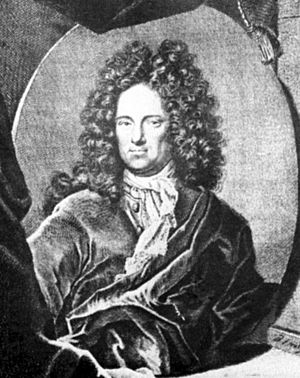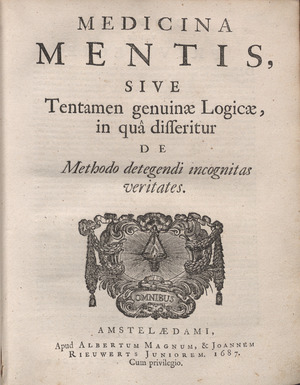Ehrenfried Walther von Tschirnhaus facts for kids
Quick facts for kids
Ehrenfried von Tschirnhaus
|
|
|---|---|

Ehrenfried Walther von Tschirnhaus.
|
|
| Born | 10 April 1651 |
| Died | 11 October 1708 (aged 57) Dresden, Electorate of Saxony
|
| Nationality | German |
| Scientific career | |
| Academic advisors | Arnold Geulincx Franciscus Sylvius |
| Notable students | Christian Wolff |
Ehrenfried Walther von Tschirnhaus (born April 10, 1651 – died October 11, 1708) was a smart German scientist. He was a mathematician, a physicist, a doctor, and a philosopher. He is famous for inventing something called the Tschirnhaus transformation in math. Many people also believe he was the first person in Europe to invent porcelain. This invention was later credited to someone else, but there is strong evidence it was Tschirnhaus.
Contents
About Ehrenfried Walther von Tschirnhaus
Ehrenfried Walther von Tschirnhaus was born in a place called Kieslingswalde. Today, this area is known as Sławnikowice in western Poland. He later passed away in Dresden, which is in Saxony, Germany.
His Education and Travels
Tschirnhaus went to school at the Gymnasium in Görlitz. After that, he studied mathematics, philosophy, and medicine at the University of Leiden in the Netherlands.
He traveled a lot during his life. He visited France, Italy, and Switzerland. He even served in the Dutch army for a short time. During his travels, he met many important thinkers. He met Baruch Spinoza and Christiaan Huygens in the Netherlands. In England, he met Isaac Newton. In Paris, he met Gottfried Leibniz, a famous mathematician. Tschirnhaus and Leibniz stayed friends and wrote letters to each other for many years. Tschirnhaus also became a member of the French Academy of Sciences in Paris.
His Work as a Mathematician
Tschirnhaus is well-known for the Tschirnhaus transformation. This is a special math trick that helps simplify algebraic equations. He published this idea in a science magazine called Acta Eruditorum in 1683.
In 1682, Tschirnhaus also studied how light reflects off curved surfaces. This area of study is called catacaustics. He showed that these curves could be "straightened out" in a mathematical way. One special curve, related to a parabola, is still called the Tschirnhausen cubic.
In 1696, another famous mathematician, Johann Bernoulli, asked a difficult math question. It was about finding the fastest path for an object to slide down. This is known as the Brachistochrone curve. Tschirnhaus was one of only five mathematicians who found the correct answer.
Tschirnhaus also made different types of lenses and mirrors. Some of these are still shown in museums today. He even built a large glass factory in Saxony. There, he made very powerful burning glasses and did many experiments.
His book, Medicina mentis (which means "Medicine of the Mind"), was published in 1687. In this book, he wrote about how to use logic and experiments to discover new things. This showed his connection to the Age of Enlightenment, a time when people focused on reason and science.
His Ideas as a Philosopher
For a long time, Tschirnhaus was not widely remembered as a philosopher. Many studies about him focus on his connections to other famous thinkers. While studying at Leiden University, he began writing letters to Spinoza. Later, he also wrote to Leibniz. Tschirnhaus was one of the first people to get a copy of Spinoza's important book, Ethics.
The Inventor of Porcelain
When Tschirnhaus returned to Saxony, he started many experiments. He mixed different types of silicates (like sand) and earths. He heated them at various temperatures. His goal was to create porcelain. At that time, porcelain was very expensive and only came from China and Japan.
As early as 1704, he showed his "porcelain" to Leibniz's assistant. He suggested to Augustus II the Strong, the ruler of Saxony, that they should build a porcelain factory. However, his idea was turned down at first.
Also in 1704, Tschirnhaus became the supervisor of a young alchemist named Johann Friedrich Böttger. Böttger was only 19 and claimed he could make gold. Böttger did not want to help Tschirnhaus with his porcelain work at first. But by 1707, he was forced to join in.
They started using special clays called kaolin and a soft mineral called alabaster. This helped their work a lot. Because of their progress, Augustus II named Tschirnhaus the director of the new porcelain factory. The ruler even ordered a large payment for Tschirnhaus. But Tschirnhaus asked to wait until the factory was actually making porcelain.
Tschirnhaus died suddenly on October 11, 1708. After his death, the porcelain project stopped.
Just three days after Tschirnhaus died, his house was robbed. According to Böttger, a small piece of porcelain was stolen. This suggests that Böttger knew Tschirnhaus had already figured out how to make porcelain. This is important evidence that Tschirnhaus, not Böttger, was the true inventor.
Work on the porcelain factory started again on March 20, 1709. A man named Melchior Steinbrück came to look at Tschirnhaus's belongings. He found Tschirnhaus's notes about making porcelain and met with Böttger. On March 28, 1709, Böttger told Augustus II that he had invented porcelain. Böttger was then put in charge of the first European porcelain factory. Steinbrück became an inspector and married Böttger's sister.
Many people who knew about the work at the time said that Tschirnhaus was the real inventor. For example, in 1719, Samuel Stölzel from the Meissen porcelain factory went to Vienna. He shared the secret recipe for porcelain. He confirmed that Tschirnhaus, not Böttger, had invented it. In the same year, the head secretary of the Meissen factory also said that the invention was "not Böttger's but by the late Herr von Tschirnhaus." He said Tschirnhaus's written notes were given to Böttger by inspector Steinbrück. Despite this, Böttger's name became very famous for inventing porcelain.
His Books
- Medicina corporis, Amsterdam, 1686.
- Medicina mentis, Amsterdam, 1687.
- Medicina mentis et corporis, with an Introduction by Wilhelm Risse. (Reprint) Hildesheim: Georg Olms, 1964.
See also
 In Spanish: Ehrenfried Walther von Tschirnhaus para niños
In Spanish: Ehrenfried Walther von Tschirnhaus para niños
- List of German inventors and discoverers
- Generalized conic




